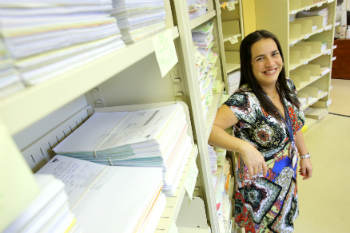An eye for detail, a passion for perfection

Maria Bonfitto works as Team Leader in Medical Records and Scanning, and while her job entails a thorough understanding of the myriad procedures required to maintain files for tens of thousands of patients every year, she shares something in common with nurses, doctors and so many other caregivers at the Children’s. “We’re here for the patients,” she says. And our patients couldn’t be in better hands.
Maria first came to the MCH 12 years ago on availability and within two years had moved to Medical Records where she was eventually hired in a permanent position. She now leads a team of 22 people—thirteen in Medical Records and nine in Scanning.
A new era for Medical Records
Since May of last year, Maria has been working with the Scanning team as they implement the step-by-step phase-in of the scanning project. When completed, all medical records will be maintained in electronic format for access on OACIS. Considering the number of patient visits in clinics and Emergency at the MCH, as well as children who are admitted, it’s easy to see why the project was rolled out in stages. “Many of our staff have acquired new skills to work in scanning,” says Maria, “and we’ve taken the time to master each stage of the process as we go.” The team has just started the final phase this month, which will involve scanning records for admitted patients.
A typical day in Medical Records sees thousands of sheets coming through their doors. Most of these arrive through internal mail, but patient files from Emergency are picked up three times a day—even on weekends. The clinical staff assign bar codes to each sheet to identify the patient, clinic and type of form being used. After a thorough process of checking and verifying their work, the documents are prepared for the scanner, which can handle several hundred pages at a time. The last step is quality assessment.
It’s all in the details
Maria is keen to point out that there is much more behind the scenes than meets the eye. Questions come up regularly about any number of details to do with a child’s file. She credits her “wonderful” team for finding ways to improve their service and always going the extra mile to ensure that records are perfect. “They do their research, and ask each other questions until they’re satisfied with the result,” she says. When physicians need to access charts from before October 2012, the Correspondence group in the Medical Records department handles their requests.
Maria is very positive about what the Scanning project will mean for patient care. “There’s a form or chart for every visit for every child. Even though it can seem like there’s an increase in the amount of information we record, it is actually making the process of accessing a child’s file more efficient,” she says.
With the Admissions project now under way, it’s going to be a busy fall for the department. “A child who is admitted to the hospital usually has many more documents than a child seen in clinic. Admissions is our final push. It’s a lot of volume. But we’re ready for it,” she says with a smile.


